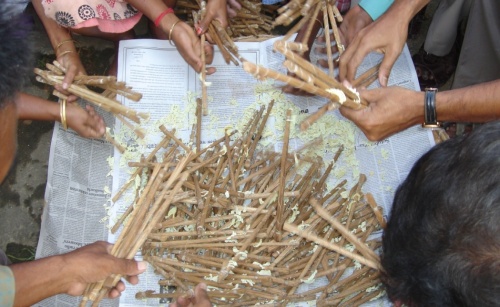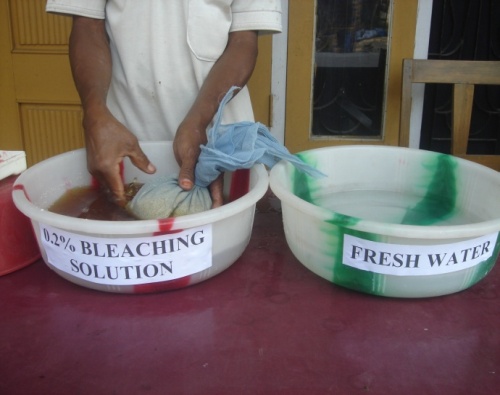Allied Sectors and Occupations
Silkworm Seed/Egg production
Mulberry seed/ egg production
Disinfection of grainage and implements
- Bamboo made house with thatched roof and mud-plastered wall is preferable for grainage.
- Disinfect the grainage rooms and appliances prior to commencement of operation.
- Wash the rooms and appliances with 5% bleaching powder solution before one day.
- Dry the appliances in sun shine for 3-4 hours before one day.
- Disinfect the rooms and appliances with a mixture of 2% formalin, 0.5-1% lime and 0.5% detergent solutions @ 1L/ sq.m after one day.
Pupal examination
- Separate out the melted, flimsy and good cocoons.
- Take out the gut portion and observe under microscope.
- Reject the lot in case there is incidence of pebrine.
- Disinfect the contaminated room before the arrival of new lots.
Preservation and protection of seed cocoons
- Immediately after the receipt of seed cocoons, spread them on trays in a
single layer to facilitate good aeration.
- Reject the seed cocoons which are melted, uzi infested, flimsy and not conforming to the characteristics of parent races.
- Preserve only the healthy seed cocoons in trays for further processing.
- Provide cross ventilation in the preservation room.
- Maintain temperature at 25 ± 1˚C, relative humidity of 75 ± 5%, 16 hour light and 8 hour dark conditions in the cocoon preservation room.
- Maintain complete darkness one day prior to emergence to avoid irregular emergence of moths.
Early eclosion/ artificial eclosion/ forced eclosion of moths
- This helps in determining the disease freeness of a batch and helps in
minimizing the loss to grainage.
- For early emergence of moths, 50-60 seed cocoons are taken from individual lots and placed into an artificial eclosion box.
- Maintain the temperature at 32-33 0C with the help of thermostat. This accelerates the development of pupae and moth emerges early.
- Examine the early emerged female moths of respective lots are under microscope to know the disease freeness of lots.
Synchronization of emergence of moths, pairing, depairing and oviposition
- Keep the cocoon preservatio0n room dark before the expected day of emergence
of moths.
- In case of variation in development of male or female pupae, the development of male pupae can be arrested by preserving them at 5-7 0C and 75 + 5% relative humidity for 3-4 days.
- Only healthy and active moths are taken for pairing.
- After 1-2 hours of emergence, the male and female moths of respective combination are allowed for 3.5 to 4 hours of pairing.
- At the time of depairing, the male and female moths are to be moved side way so that the moths are separated easily without causing injury to reproductive organs.
- The mated female moths are taken in a separate container and induced for urination.
- Moths are placed on egg sheet and covered with cellules and kept in semi dark condition for oviposition.
- Under proper preservation (5-7 0C), male moths can be used for second pairing by giving 1-2 hours rest.
- Throughout the process of pairing, depairing and oviposition, optimum temperature of 25 ± 1 0C and relative humidity of 75 ± 5% should be maintained.
Moth examination
- Examine the mother moth either individually or in mass for pebrine disease.
Surface sterilization of eggs
- Dip the egg sheets in 2% formalin for 10-15 minutes. This helps in removal of
pathogens adhering to the egg shell and further prevents secondary
contamination.
- Wash the eggs in formalin solution. It helps in firm adherence of eggs to the sheet.
Incubation eggs
- Maintain temperature of 25 ± 1˚C, relative humidity of 75 ± 5%, 16 hours of
light and 8 hours darkness.
- During the pinhead stage or before two days of hatching, maintain total darkness
for uniform development of embryo and hatching of larvae at a time on a single
day.
Source
Directory of Sericulture Technology 2008, Karnataka State Sericulture
Research and Development Institute, Bangalore- 5 60 062.
Eri Seed/ Egg Production
Seed cocoon selection

- Select cocoons based on physical characteristics e.g. compactness, shape, size and number of cocoon per kg (not more than 350 cocoons/kg).
Disinfection of grainage room
- Wash the grainage room and appliances with 5% bleaching powder solution, 3 days before consignment of seed cocoons.
- Same disinfection procedure should be adopted after completion of grainage.
- In the event of pebrine incidence during grainage, fumigate with 5% formaldehyde solution under high humid condition with the appliances inside.
- Open the room after 24 hours.

Transportation of seed cocoon
- Transport the cocoons in plastic trays during early morning or in the evening hours to avoid direct exposure to sunlight.
Storage of seed cocoon
- Seed cocoons are stored in single layers @ 500 cocoons per tray (size 3ft x 2ft) arranged in racks.
Emergence of moths and sorting of couplings:

- Moth emergence occurs after 17-18 days of spinning in summer and 30 t0 35 days in winter.
- Moth emergence takes place in the evening hours as well as in the morning hours.
- Collect the emerged moths in moth cage approximately in the ratio of male :
female at 60 : 40. The paired moths are allowed to couple for 6 hrs.
- Decouple the moths and allow the female moths to lay eggs on kharika/pouch.
Moth Examination
- Conduct microscopic examination of mother moths on 3rd day for basic and 0n 4th day for commercial seed following Fujiwara technique.

Harvesting of eggs
- Collect all the disease free layings alongwith the kharika in a tray for harvesting. Transfer the harvested eggs to a piece of nylon net for washing.
Degumming and surface sterilization of eggs
- Dip the eggs in 0.2% bleaching solution for 5 minutes.
- Wash the eggs with fresh water and soap and finally with fresh water.
- Spread the sterilized eggs on a blotting paper for drying in the shade.
- Weigh the dried eggs and pack in specially designed egg boxes for supply.

Source
Eri Silkworm Seed Production Centre, Azara, Guwahati





